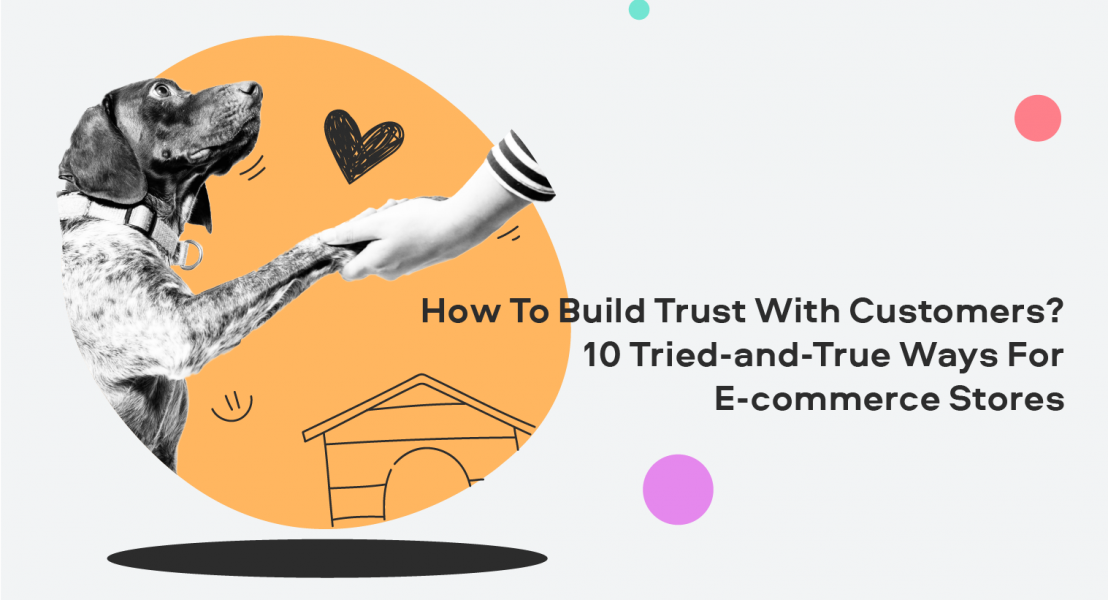We use cookies to improve the services we offer you. By continuing to browse this site, you consent to keep them in accordance with our Privacy Policy.
×We use cookies to improve the services we offer you. By continuing to browse this site, you consent to keep them in accordance with our Privacy Policy.
× 3,102
3,102
 17 min
17 min

To develop your business online in today’s digital age, it’s not wrong to state that the first step is to create client trust in your brand. However, It will be a long and challenging process to build trust with customers online.
Thanks to mobile technology and social media, the globe has never witnessed such a significant consumer impact as it does now. They are pleased, they are upset, and it all affects your business.
As a result, this article will assist you in identifying methods to increase customer trust in e-commerce stores.

Satisfaction is one of the three consequences of trust, along with perceptions of danger and continuity. Trust and dedication are essential to creating brand value. Cooperation is the result of commitment and confidence, which is necessary for a successful online business partnership.
Here are four reasons why it’s crucial to build customer trust with your eCommerce business.
Positive customer reviews and repeat purchases will follow once clients have come to trust your business’s products or services. Customers who are satisfied make your brand more trustworthy to others who aren’t currently using it. They will also raise your profile.
Today, having a solid online presence may help you acquire a lot of trust from those who aren’t current customers and increase your sales.
To develop an excellent reputation for your firm, you need to establish trust with customers. As soon as people believe in your business, they want to conduct business with you.
Consequently, customers will be more supportive, loyal, and engaged. As a result, businesses will attract more consumers who are prepared to invest in their products when their customers support them.
Building a successful firm relies heavily on reputation. Losing business because of your bad reputation is a surefire way to lose customers. Alternatively, a good reputation increases a company’s perceived value, attracts more customers, and drives it to the next level of success.
Repeat consumers are less expensive to market to, spend more money, and buy more frequently. Only 27% of first-time consumers become repeat clients. Customers must be rewarded for their loyalty, and businesses must invest in this process.
Even if they don’t recall the brand name or the commercial, customers subconsciously retain the experience of being connected with a brand. As a result, branding and marketing can aid in the pursuit of a devoted client base. They must, however, be done correctly.
Oddly enough, your marketing engine has performed best where you have interfered with the least. Though it is a double-edged sword, word of mouth reigns supreme. You will strike the jackpot when individuals start promoting your brand to each other.
Businesses often find it challenging to maintain a competitive advantage. Companies need to stay on top by keeping up with current trends to adapt to the ever-changing industry. So it’s hard to tell what’s working and what’s wasting time.
For businesses in today’s digital economy, building trust online is essential.
That’s what’s going to keep firms growing and thriving in a competitive market.

The Internet is a virtual environment of low trust since nothing is accurate, and there will be a practical test based on the context.
Try to imagine. Take a look at a brand or website that you’ve never seen or heard of before. Do you visit their website to make a purchase? No, you don’t. Instead, you approach the conflict cautiously and with a heightened awareness of your surroundings.
A website’s credibility is quickly assessed as soon as you land on it. Questions are popping up one after the other:
Your trust criteria are not met if the answers to these questions do not satisfy your expectations.
So the difficulties that businesses face to build consumer trust will include:
As a result, when you run an internet business, you’re fighting an uphill struggle for your consumers’ complete trust and a rise in brand reputation.
To get them to drop their defenses, you’ll have to battle tooth and nail.

To answer how to build trust with customers, here are some highly effective options that we have researched to help e-commerce businesses choose and apply them properly.
Because in the present online shopping age, customers cannot physically check whether a product is authentic and assured throughout picking and reviewing items.
In this way, straightforwardly showing vital facts might offer consumers a sense of security. It gives them a cause to trust that the vendor is legitimate and that the purchasing rules are acceptable and assured, at the very least.
On the homepage, contact information, shop address, and return policies should be prominently displayed. Those clients who have never purchased a product from a new company do not have to fear because this information is readily available.
As part of a testimonial, consumers describe their experience with your product or service, why they picked it, and how it has benefited them. Customer testimonials are commonly used in promotional materials, such as advertising, brochures, or on a business’s website.
As well as generating leads for the sales team, testimonials’ primary objective is to create customer connections. As a result of this, marketing and customer care teams must use good evaluations as a strategy to attract and convert prospects.
You should select the ten most lucrative clients, cultivate your connection with them and ask them directly about their real-life experiences after using your products/services. Then try to find ways to convert these stories into testimonials or case studies that you can share with future customers.
Putting testimonials on the front page of your website will help shoppers have a favorable view from the first minute they enter your e-commerce store.
Testimonials and reviews differ in a few crucial ways. Evaluations tend to be shorter than testimonials because of their condensed nature.
Generally, customer reviews will detail a specific encounter or a general summary of how a consumer thinks about a company’s products and services. One or two words, a single sentence or a brief paragraph, might be used to describe the evaluation.
Businesses can send customers an email asking for a few product reviews or include a product review gift card when customers can comment about a product or service.
Their length makes the number of positive evaluations more essential than the quality of detail. Examining products and services from several perspectives is a significant benefit of reviews.
Due to the popularity of online shopping in the 4.0 age today, consumers typically read the reviews of other customers before making a purchase decision. From there, they will have a favorable view of your business and then establish trust in the quality of the products you provide.
It’s no doubt that in the age of digital technology, boosting product brands with beautiful, high-quality photographs can help you build consumer trust. It is essential to take photos of promotional items to attract customers. Customers’ trust in online vendors is influenced by the quality of their product images, influencing their purchase decisions.
Quality product photography serves to attract buyers and helps you solve how to build trust with customers. Moreover, this offers you a competitive advantage over your competition.
To minimize delayed loading owing to high-quality photographs taking up a lot of space, you must compress or re-format the image before exporting it. In addition, quality photos of the product will give users a genuine feeling from the material to the style of the product you sell, thereby increasing their trust in the store.
Moreover, you may upload a video of the product from various perspectives so that buyers can view the actual substance and design of the product, therefore reducing the likelihood that customers would be disappointed upon receiving the product.
Currently, every customer who purchases valuable goods will obtain a warranty card. The same is valid for e-commerce items. Warranty or refund policies are regarded as an essential component and companion publication.
Warranty cards usually go to authentic items, which means that the warranty policy is seen as an assurance of the items’ origin and dependability. This is why a product’s warranty policy will provide buyers peace of mind when they acquire the product.
In addition to the origin element, the quality factor makes the goods susceptible to the warranty policy. If a product is easily damaged and has a limited shelf life, no one, no business owner, will offer a guarantee or a return policy for it.
Warranty and return policies are also created to give the buyer a seller’s promise regarding their sales policy. Consequently, buyers who have the warranty card in hand may feel sure to make a solid purchase.
When customers purchase a product with an explicit warranty and return policy, utilizing the goods is more efficient. The product will not be readily damaged as a result of this. Additionally, this product is unlikely to be plagued by technological issues. A buyer will also not have to pay a lot of money for repairs or maintenance on the goods.
Creating media content for the product or simply putting product information on the purchase page significantly impacts on whether the buyer is satisfied with the product and will return. Customer buying behavior might be influenced by content.
As well as being visually appealing, it must also be instructive in a simple, unpretentious manner. In other words, the information must be as impartial as possible while yet attracting people to purchase the goods.
The description of genuine product information from colors, materials, and designs will assist buyers to feel simple to pick and experience the goods using their eyes and imagination.
Customers will no longer be dissatisfied when they receive the product since it is not what they expected. Now that your consumers know they won’t be disappointed, you’ve been able to win their trust in future transactions.
SSL (or Secure Sockets Layer) is a digital certificate that verifies a website’s identity and provides a secure connection between the website and the server.
Visitors to your website who use Google Chrome will receive a ‘Not Secure’ notice in the search box if you don’t have an SSL certificate or Wildcard SSL (for Unlimited subdomain). This serves as an instant barrier to new clients who are unfamiliar with your brand.
As well as proving your business’s legitimacy, SSL guarantees that your clients’ access to the server is always encrypted with the highest level of protection and privacy available to them.
In addition, it’s an indication that the website exists and that it’s secure to make a transaction on the web. Website owners should ensure their consumers are in a safe and secure environment at all times. This is also one of the effective ways to build trust with customers online.
Buyers and sellers used only to accept one type of direct payment: cash delivery. This method is still widely used today. This is still a standard payment method even when buying products on the Internet since buyers must be sure of the item they purchased before paying to protect their security.
Payment solutions that save merchants and buyers time and effort are a natural result of the e-commerce market’s expansion. Buyers may easily select a payment option with which they feel comfortable.
Customers can also receive a rapid refund if they are dissatisfied with your product if they use an online payment channel to make their purchases. As a result, you’ll be able to establish customer trust in your site in no time.
When consumers are satisfied with the customer service they receive, they will tell others about the product. Many consumers check the reviews of past customers before making a purchase decision. A happy client who demonstrates this will do much more than tell you that your product is terrific.
That is to say, taking good care of a client and keeping them happy with the quality of your products and services is an excellent method to boost your company’s credibility and expand the number of prospective consumers enormously.
In addition, to increase the credibility and professionalism of your online store, you can add a service to answer customer inquiries via live chat, which is both quick and satisfying with timely responses.
Moreover, taking good care of existing clients and earning their pleasure and trust is a fantastic approach to turning them into loyal consumers when they have requirements or purchases. Businesses that provide excellent customer service after a purchase demonstrate that they value their consumers.
Social media marketing is a method of communicating with customers using social media platforms to raise brand recognition and promote e-commerce firms’ products and services.
A whopping 84 percent of customers in the 18-29 age group use Instagram, Facebook, Pinterest, Snapchat, and Twitter. According to a recent study, 81% of Instagram users use social networks to research products and services online. There are up to 130 million monthly shoppers on Instagram, according to the social networking site.
As previously indicated, a large spectrum of potential consumers may easily access product information through social media platforms. Purchasers express their opinion on social media through testimonials, reviews, photographs, and even comments on posts after making a purchase. Here, your store will deal with real-life interactions.
Buyers stay engaged on social media as the firm builds its client base and its revenues increase. By spreading the word about these items, a robust network of followers and influencers is formed.
Therefore, if you neglect social media, you will lose many benefits, your competitive market position, and your company’s professionalism and trustworthiness.
Developing a more professional e-commerce website is one option that delivers excellent economic efficiency and develops client trust in the online market.
Your online store’s professionalism will be enhanced with a professional e-commerce website with excellent features. Therefore, your firm will receive high marks for trustworthiness in the minds of your clients as a consequence of their positive buying experience on your site.
You can consider upgrading your existing website to a Progressive Web App (PWA) to add new features and enhance the performance of your e-commerce store. PWA is an online form that integrates with an app developed on website technology but delivers the same experience as a Native App. It’s a hybrid between a Native App and a Web App.
Using a mobile browser, users may download the PWA website to their phones. On their phone, users can then go back and visit the website by clicking an icon, similar to what you do when you click on a native app icon to access software.
Isn’t it more convenient than when the app and website are separate?
Because of such convenience and professionalism, many customers have trusted to choose businesses that use PWA as a familiar place to make regular purchases.
The e-commerce sector is usually characterized by solid rivalry and fast elimination. As a result, it will be tough for e-commerce companies to establish their brand ahead of the competition.
However, we believe that the techniques presented in this post have helped companies discover solutions to build trust with customers. Good luck!
If you’re worried about the complexity of the operating procedure, you can use the following methods to gain customer trust in your e-commerce store:
There is no such thing as a problematic approach to developing consumer trust with your e-commerce business. It’s just a more complicated implementation. It is to professionalize your website and enhance your store’s exposure on social media.
If you are not a computer-aware person, website development will be pretty complex, but as previously said, you may employ service providers to assist you. When it comes to increasing social media awareness, the most crucial aspect is patience and developing an efficient advertising plan.
To build customer trust for your online store with a limited budget, you can refer to the following ways:
Developing a more professional e-commerce website is more expensive than other solutions to build customer trust in your online business.
However, that investment will provide you with a high level of efficiency in acquiring a significant number of consumers. Furthermore, packages that include web development services might save you a considerable amount of money.
To build trust with customers for an e-commerce startup, you can refer to the following solutions: